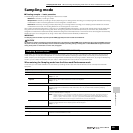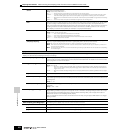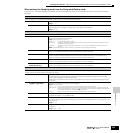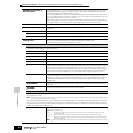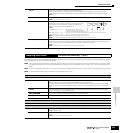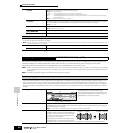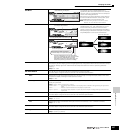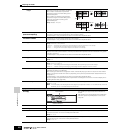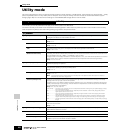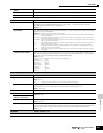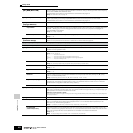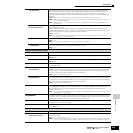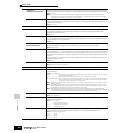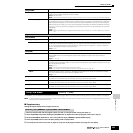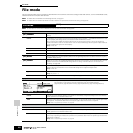
Reference Sampling Mode
Sampling Job mode
259
Owner’s Manual
■ Supplementary
Tips for using the Slice Types
• Slicing percussive phrases having short decays
First, try slicing using “beat1.” If the result has a weak attack or the
release portions of the phrase seem to overlap, try again using
“beat2.” Try adjusting the envelope sensitivity for finer control.
If after using “beat1” the attack portions overlap or the overall
rhythmic feel is degraded, try again using “beat3.” Use the
SubDivide parameter to adjust the slice resolution, and make final
adjustments with the Envelope Sensitivity parameter.
• Slicing phrases having long decays
First, try slicing using “phrase1.” If the result has a weak attack or the
release portions of the phrase seem to overlap, try again using
“phrase2.” Use the SubDivide parameter to adjust the slice
resolution, and make final adjustments with the Envelope Sensitivity
parameter.
If after using “phrase1” the points between the slices sounds rough
and the overall feel is choppy, try again using “phrase3” or “phrase4”
and set SubDivide to a finer resolution. Make final adjustments with
the Envelope Sensitivity parameter. The “phrase3” setting is
generally best for sustained strings or brass type sounds with no
vibrato — in other words, the pitch remains constant. It can also
produce echo-like effects when applied to percussive phrases with
short decay. The “phrase4” setting is generally best for sustained
strings or brass type sounds with vibrato, as well as vocal phrases.
Wave Memory Required for Slice Operations
Individual wave data slices created through slice operations require
approximately 1.5 times the original memory because a tail section is
automatically added and fade-in and fade-out sections are
automatically created at the beginning and end of the wave data.
This helps to maintain maximum sound quality when the tempo is
increased, and results in smoother connections between slices (no
tail section is created when the “quick” slice type is selected).
A memory work area is required for the processing calculations
carried out for each slice operation, as well as sufficient memory to
hold the completed waveforms. When the sampling frequency is
44.1 kHz, the approximate amount of memory (expressed in
kilobytes) required for each slice type is listed below.
beat1: Original wave size x N + (0.3 x number of slices)
beat2: Original wave size x N + (0.2 x number of slices)
beat3: Original wave size x N + (0.3 x number of slices)
phrase1: Original wave size x N + (5.8 x number of slices)
phrase2: Original wave size x N + (1.4 x number of slices)
phrase3: Original wave size x N + (0.4 x number of slices)
phrase4: Original wave size x N + (1.4 x number of slices)
quick: Original wave size x 3 + (0.7 x number of slices)
For monaural samples N = 5.5, and for stereo samples N = 8.
Also, the number of slices is doubled for stereo samples.
04: Name
This Job lets you assign a name to the selected Waveform.
For specific instructions on naming, refer to page 53 in the Basic Operation section.
[F3] OTHER
01: Clean Up Memory
This Job deletes all the waveforms to which User voices or Sample voices are not assigned.
02: Optimize Memory
This Job optimizes the memory (DRAM) for sampling.
03: Delete All
This Job deletes all the waveforms.
04: Convert to Drum Voice
This Job lets you convert the selected waveform to a specific Drum voice.
Source
Waveform
Sliced
Waveform
Ta il section
Fade section



